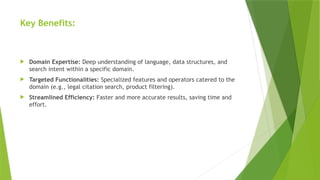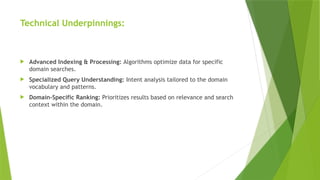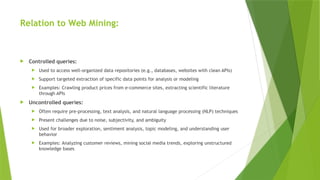Web Minnig and text mining presentation
- 1. Deeper Dive into Purpose-Built Search: A Bullet Point Journey
- 2. Core Concept Tailored information retrieval systems designed for specific domains or user needs, offering superior relevance and efficiency compared to general-purpose search.
- 3. Key Benefits: Domain Expertise: Deep understanding of language, data structures, and search intent within a specific domain. Targeted Functionalities: Specialized features and operators catered to the domain (e.g., legal citation search, product filtering). Streamlined Efficiency: Faster and more accurate results, saving time and effort.
- 4. Diverse Applications: E-commerce: Advanced product comparisons based on specific criteria. Legal Research: Efficient navigation of databases with specialized search operators. Enterprise Search: Role-specific search for internal documents and resources. Media & Entertainment: Granular search by genre, cast, release date, etc. Scientific Exploration: Domain-specific ranking algorithms for relevant research papers. Healthcare: Search medical databases based on symptoms, diagnoses, and medications. Education: Curated search experiences for students and educators across disciplines.
- 5. Technical Underpinnings: Advanced Indexing & Processing: Algorithms optimize data for specific domain searches. Specialized Query Understanding: Intent analysis tailored to the domain vocabulary and patterns. Domain-Specific Ranking: Prioritizes results based on relevance and search context within the domain.
- 6. Emerging Trends: AI-Powered Insights: Extracting deeper connections and patterns from search results. Cross-Domain Integration: Seamlessly search across specialized tools for broader exploration. Personalization & Adaptability: Intuitive interfaces learning from user habits and preferences.
- 7. Future Implications: Democratization of information access across various domains. Increased productivity and efficiency in knowledge-driven tasks. Personalized learning experiences and deeper understanding of complex topics.
- 8. Controlled Queries vs. Uncontrolled Queries in Web Mining:
- 9. Concept Controlled queries: Formulated by the researcher with specific goals and requirements, often tailored to a particular domain or dataset. They leverage structured query languages (e.g., SQL, XPath) or web APIs to precisely retrieve relevant data. Uncontrolled queries: Submitted by users (e.g., search keywords, reviews, forum posts) with varying levels of clarity, structure, and intent. They represent spontaneous information needs in diverse formats and require parsing, understanding, and interpretation.
- 10. Key Differences:
- 11. Key Differences:
- 12. Relation to Web Mining: Controlled queries: Used to access well-organized data repositories (e.g., databases, websites with clean APIs) Support targeted extraction of specific data points for analysis or modeling Examples: Crawling product prices from e-commerce sites, extracting scientific literature through APIs Uncontrolled queries: Often require pre-processing, text analysis, and natural language processing (NLP) techniques Present challenges due to noise, subjectivity, and ambiguity Used for broader exploration, sentiment analysis, topic modeling, and understanding user behavior Examples: Analyzing customer reviews, mining social media trends, exploring unstructured knowledge bases
- 13. Considerations: Choice between controlled and uncontrolled queries depends on research objectives, data availability, and resource constraints. Both approaches can be valuable, and often they are combined for comprehensive web mining. Uncontrolled queries offer broader insights but necessitate deeper understanding and careful processing.
- 14. Web Mining Examples: Travel website data: Controlled queries could be used to extract hotel listings based on specific criteria (location, price, amenities). Uncontrolled queries could analyze visitor reviews to understand sentiment and identify areas for improvement. News analysis: Controlled queries could retrieve articles on specific topics from credible sources. Uncontrolled queries could explore broader social media discussions to uncover emerging trends and public opinion.
- 15. Future Directions: Integration of semantic web technologies and advanced NLP techniques to better understand unstructured data. Development of adaptive mining methods that can dynamically switch between controlled and uncontrolled queries based on context and needs. Enhanced use of explainable AI (XAI) to make query interpretation and analysis more transparent.
- 16. Understanding Word Embedding and Word2Vec for Efficient Language Processing https://www.youtube.com/watch? v=viZrOnJclY0
- 17. Understanding Word Embedding and Word2Vec for Efficient Language Processing Word embeddings and the Word2Vec model can be used to assign numerical representations to words based on their context, allowing for more efficient processing of language and understanding of word similarities.
- 18. Understanding Word Embedding and Word2Vec for Efficient Language Processing Key insights • Word embeddings allow similar words to have similar numbers, making it easier to analyze and understand text data. • Words with similar meanings and usage should be assigned similar numbers in word embedding to help neural networks learn more efficiently. • Backpropagation is used to optimize the random values of the weights in a neural network, enabling the network to make accurate predictions. • The word embedding model uses input words to predict the next word in a phrase, assigning higher values to the desired output word. • Optimizing the weights of word embeddings can potentially improve the performance of natural language processing models by capturing semantic relationships between words. • Using word embeddings can optimize the weights in a neural network, allowing it to learn how similar words are used and improve language processing. • Word2vec efficiently creates word embeddings by selectively optimizing weights for specific outputs, allowing for the creation of multiple embeddings for each word in a large vocabulary.
- 19. Q&A What are word embeddings and Word2Vec? —Word embeddings and Word2Vec are methods used to convert words into numerical representations based on their context, making it easier to process language and understand word similarities in machine learning. How does a neural network determine word associations? —A simple neural network can determine the association between words and numbers based on their context in phrases, allowing for the prediction of the next word in a phrase.
- 20. Q&A Why is training a neural network important for word embeddings? —Training a neural network is important for correctly predicting the next word in a phrase and adjusting word embeddings to make similar words more similar to each other based on their context. What strategies does Word2Vec use to increase context in word embeddings? —Word2Vec uses two strategies, continuous bag-of-words and skip-gram, to increase context in word embeddings by predicting surrounding words based on the middle word and vice versa.
- 21. Q&A How does Word2Vec optimize training for word embeddings? —Word2Vec speeds up training by using negative sampling to optimize only for the words we want to predict, efficiently creating word embeddings by selecting a few words to predict and optimizing only a fraction of the total weights in the neural network.
- 22. Timestamped Summary 00:00 Word embeddings and word2vec convert words into numbers, allowing similar words to have similar numerical representations for easier use in machine learning algorithms. 02:38 Similar words should have similar numbers to help a neural network learn and apply knowledge, and a simple neural network can determine word-number associations based on context. 04:54 We create a neural network with inputs for each unique word, connect them to activation functions, and optimize the weights through backpropagation to associate numbers with each word. 06:20 Using word embeddings and the Word2Vec model, we can predict the next word in a phrase by training a neural network to assign values to input words, connect them to activation functions with weights, and run the outputs through the softmax function for classification.
- 23. Timestamped Summary 08:18 Word embeddings are adjusted through backpropagation to make words that appear in the same context more similar to each other, and the neural network accurately predicts the next word based on input. 10:37 Training a neural network with Word2Vec can help process language and understand how similar words are used by assigning numbers to words based on their context. 12:31 Word2Vec uses multiple activation functions and a large vocabulary to efficiently create word embeddings by optimizing only a fraction of the total weights in the neural network.
- 25. How to download pre-trained models and corpora https://radimrehurek.com/gensim/auto_examples/howtos/ run_downloader_api.html
- 26. Pre trained corpus A pre-trained corpus is a massive collection of text data that has already been used to train a language model. Think of it like a vast library of books that a language model has already read and learned from. This "reading" process lets the model understand the nuances of language, like how words are used together, sentence structure, and different writing styles.
- 27. What's in it? A pre-trained corpus can contain diverse sources like books, articles, code, websites, and even social media conversations. The size can vary, with some corpora containing billions of words!
- 28. Why is it used? Training a language model from scratch requires immense computing power and data. Pre-trained corpora save time and resources by providing a foundation of knowledge. The model can then be fine-tuned on specific tasks like summarizing text, translating languages, or writing different kinds of creative content.
- 29. Benefits: Faster training of language models. Improved performance on various NLP tasks. Adaptability to diverse domains by fine-tuning.
- 30. Examples: Well-known pre-trained corpora include Wikipedia, BookCorpus, and Common Crawl. Specialized corpora exist for legal documents, medical texts, or scientific papers.





























